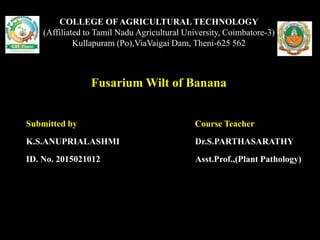Fusarium wilt banana
- 1. COLLEGE OFAGRICULTURAL TECHNOLOGY (Affiliated to Tamil Nadu Agricultural University, Coimbatore-3) Kullapuram (Po),ViaVaigai Dam, Theni-625 562 Fusarium Wilt of Banana Submitted by Course Teacher K.S.ANUPRIALASHMI Dr.S.PARTHASARATHY ID. No. 2015021012 Asst.Prof.,(Plant Pathology)
- 2. Scientific classification Kingdom: Fungi Division: Ascomycota Class: Sordariomycetes Order: Hypocreales Family: Nectriacea Genus: Fusarium Species: F. oxysporum
- 3. HISTORY & DISTRIBUTION Fusarium oxysporum f.sp.cubense is a soil-borne fungus that causes Fusarium wilt, which is considered to be the most destructive disease of bananas. The fungus is believed to have evolved with its host in the Indo-Malayan region, and from there it was spread to other banana-growing areas with infected planting material.
- 4. LIFECYCLE
- 5. Symptoms: ? Externally, the first obvious signs of disease in most varieties are wilting and a light yellow colouring of the lower leaves, most prominent around the margins. They eventually turn a bright yellow colour with dead leaf margins. ? Splitting of pseudostem base is a characteristic symptom.
- 6. ? Internally, symptoms first become obvious in the xylem (water conducting) vessels of the roots and the rhizome. These turn a reddish-brown to maroon colour as the fungus grows through the tissues. ? When a cross-section is cut, the discolouration appears in a circular pattern around the centre of the rhizome where the infection concentrates due to the arrangement of the vessels. As symptoms progress into the pseudo-stem, continuous lines of discolouration are evident when the plant is cut longitudinally
- 7. Identification of pathogen: ? The casual organism is Fusarium oxysporum f.sp.cubense. ? This pathogen contains colonies of white to purple pigemented mycelium. Hyphae are septate and hyaline. Conidiaphores are short and simple and having macroconidia and microconidia ? Macroconidia usually produced abundantly, slightly sickle-shaped, thin-walled, with an attenuated apical cell and a foot-shaped basal cell. They are three to 5-septate measuring 23-54 x 3-4.5 ?m.
- 8. ? Microconidia are abundant, mostly non-septate, ellipsoidal to cylindrical, slightly curved or straight, 5-12 x 2.3-3.5 ?m occurring in false heads from short monophialides. ? The disease is soil borne and the fungus enters the roots through the fine laterals. ? The incidence is high in acid alluvial soils. ? The pathogen is easily spread by infected rhizomes or suckers, farm implements or vehicles, irrigation water
- 9. ? MANAGEMENT: ? Cultural method ? Practice proper crop rotation with paddy/sugarcane once or twice followed by banana for 2-3 cylces ? Plant wilt resistant cultivars such as Poovan and Nendran in endemic areas ? Proper care should be given when planting susceptible cultivators such Rasthali, Monthan, Karpuravalli, Kadali, Pachanadan by selecting healthy suckers from disease fields ? Remove and destroy infested plant material after harvest
- 10. ? When only 1-3 plants are infected, kill and chop up the diseased plants and stew all the material in water at a temperature of at least 70 deg C for 30 minutes. ? Grow healthy plants with proper fertilization, irrigation, weed control ? Provide good drainage especially during rainy season ? Soil application of rice chaffy grain or dried banana leaf formulation or well decomposed compost around the plants
- 11. Mechanical method ? Machinery and equipment should be treated with a sanitary solution such as Farmcleanse? ? Footwear, which may have contacted banana plants or soil around banana plants elsewhere, should not be worn on the farm. ? Provide mechanical barriers in and around the infected plants Biological method ? Application Pseudomonas fluorescens @ 2.5kg/ha bactericide can also be applied along with farmyard manure and neem cake. ? About 60 mg of Pseudomonas fluorescens (in a capsule) can be applied in a 10 cm deep hole made in the corm.
- 12. ? Application of bio control agents like Trichoderma viride @ 25 g for 4 times once at the time of planting in the planting pit and remaining doses at third, fifth and seventh month after planting ? Application of T.harzianum Th-10, as dried banana leaf formulation @ 10g/platn in basal + top dressing on 2,4,and 6 months after planting
- 13. Chemical method ? Application of 2 per cent of Carbendazim as injection of Carbendazim 50 ml capsule application ? Paring (pralinge removal of roots and outer skin of corm) and dipping of the suckers in clay slurry and sprinkled with Carbofuran granules at 40g/corm ? Soil drenching of Carbendazim 0.2 per cent solution alternated with Propiconozole 0.1% around the pseudostem at bimonthly intervals starting from five months after planting ? Application of urea + sugarcane trash (250g/pit) followed by lime (1Kg/pit) and neem cake (1-2Kg/pit) ? Application of neem cake @ 250 Kg/ha was most effecgtive in controlling Fusarium wilt in Rasthali cultivar
- 15. Isolation of Fusarium oxysporum f.sp.cubense
- 16. Conidia of Fusarium oxysporum f.sp. cubense















